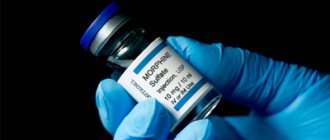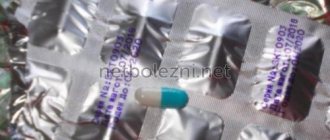Write a review
Reviews: 0
Manufacturers: Sanavita Gesundheitsmittel Gmbh & Co.Kg
Active ingredients
- Phenoxymethylpenicillin
Disease class
- Purulent and unspecified otitis media
- Acute and subacute endocarditis
- Nonspecific lymphadenitis
- Acute pharyngitis, unspecified
- Pneumonia without specifying the pathogen
- Chronic sinusitis
- Bronchitis, not specified as acute or chronic
- Lichen ruber planus
- Rheumatism, unspecified
- Scarlet fever
- Erysipelas
- Acute tonsillitis, unspecified
Clinical and pharmacological group
- Not indicated. See instructions
Pharmacological action
- Antimicrobial
- Antibacterial
- Bactericidal
Pharmacological group
- Penicillins
Pharmacodynamics and pharmacokinetics
The principle of action is based on suppressing the process of cell wall synthesis.
Phenoxymethylpenicillin has a bactericidal effect against most gram-positive bacteria (streptococci, staphylococci), a small part of gram-negative cocci (neisseria), treponemas, corynobacteria, listeria.
The drug has no effect on Streptococcus spp., the main difference of which is the ability to independently produce penicillinase (a specific enzyme that breaks down and inactivates beta-lactam antibiotics).
Phenoxymethylpenicillin does not affect the activity of viruses, causative agents of amebiasis , most gram-negative cocci, and rickettsia.
The active component is considered acid-resistant and is destroyed upon contact with penicillinase.
Pharmacological properties of the drug Phenoxymethylpenicillin
Phenoxymethylpenicillin is a β-lactam antibiotic of the penicillin group. Acts bactericidal. It is acid-stable and well absorbed from the digestive tract, allowing it to be taken orally. Destroyed by penicillinase. Active against pyogenic and hemolytic streptococci, pneumococci, gonococci and meningococci, listeria. Erysipelothrix insidiosa , corynebacteria, anthrax bacillus, actinomycetes, Clostridia tetanus and other anaerobic clostridia, Treponema pallidum and most strains of Leptospira are sensitive to phenoxymethylpenicillin Less sensitive are Streptococcus viridans (active against 70–80% of strains), enterococci (20–40% of strains are sensitive), and in high concentrations have an effect on some gram-negative E. coli, for example Escherichia , some forms of Proteus and Salmonella. All strains of Staphylococcus aureus that produce penicillinase (90% of all hospital strains of staphylococcus), Staphylococcus epidermidis , group D streptococci ( Streptococcus faecalis ), pseudomonas, Brucella, Francisella, Bordetella, mycobacteria, mycoplasma, rickettsia, bedsonia, fungi, protozoa are resistant; From the group of anaerobic microbes, B. fragilis . In recent years, there has been a change in the sensitivity of gonococci and hemolytic streptococci to penicillin. In addition to most gram-negative bacteria, rickettsia, viruses, protozoa, and fungi are resistant to phenoxymethylpenicillin. The maximum concentration in blood plasma is observed 1 hour after ingestion on an empty stomach or 2 hours after ingestion with food; The therapeutic concentration is maintained for 4 hours. Compared to benzylpenicillin, phenoxymethylpenicillin penetrates tissues more easily and in large quantities and is released from the body more slowly. The biological half-transformation period is about 30 minutes. Within 6 hours, about 30–40% is excreted unchanged in the urine. Penetrates the placental barrier and enters breast milk. Removed by hemodialysis.
Indications for use
The antibacterial drug Phenoxymethylpenicillin is prescribed for infectious lesions of the oral cavity ( actinomycosis , periodontitis , bacterial stomatitis ), respiratory system ( pneumonia , bronchitis ), skin and adjacent soft tissues ( contagious impetigo , cellulitis, abscess, furunculosis, skin migrating rashes of an erythematous nature, erysipeloid) .
Instructions for use of Phenoxymethylpenicillin are recommended to prescribe the medication for botulism , tetanus, lymphadenitis (inflammatory disease of the lymphatic system), diphtheria, anthrax , syphilis, gonorrhea, leptospirosis.
The drug is prescribed to prevent relapses of bacterial endocarditis , rheumatoid arthritis, chorea minor, glomerulonephritis, rheumatism , as well as to prevent infectious complications after surgical interventions.
Similar drugs:
- Augmentin Oral tablets
- Tea tree DN Ointment for external use
- Augmentin Powder for suspension for oral administration
- Bactrim Oral suspension
- Dioxydin Mouth rinse solution
- Pancef Oral tablets
- Nifuroxazide (Nifuroxazide) Oral tablets
- Cifran OD Oral tablets
- Pancef Granules for the preparation of suspension for oral administration
- Augmentin ES Powder for oral solution
** The Drug Directory is intended for informational purposes only. For more complete information, please refer to the manufacturer's instructions. Do not self-medicate; Before starting to use the drug Phenoxymethylpenicillin, you should consult a doctor. EUROLAB is not responsible for the consequences caused by the use of information posted on the portal. Any information on the site does not replace medical advice and cannot serve as a guarantee of the positive effect of the drug.
Are you interested in the drug Phenoxymethylpenicillin? Do you want to know more detailed information or do you need a doctor's examination? Or do you need an inspection? You can make an appointment with a doctor - the Euro lab is always at your service! The best doctors will examine you, advise you, provide the necessary assistance and make a diagnosis. You can also call a doctor at home . Euro lab clinic is open for you around the clock.
** Attention! The information presented in this medication guide is intended for medical professionals and should not be used as a basis for self-medication. The description of the drug Phenoxymethylpenicillin is provided for informational purposes and is not intended for prescribing treatment without the participation of a doctor. Patients need to consult a specialist!
If you are interested in any other drugs and medications, their descriptions and instructions for use, information about the composition and form of release, indications for use and side effects, methods of use, prices and reviews of drugs, or you have any other questions and suggestions - write to us, we will definitely try to help you.
Side effects
The antibiotic can cause allergic responses in the form of rhinitis, hyperemia (local redness) of the skin, angioedema, conjunctivitis, and urticaria.
anaphylactic shock , eosinophilia, serum sickness, fever and arthralgia develop during treatment
Phenoxymethylpenicillin tablets can provoke the development of leukopenia, pancytopenia, hemolytic anemia , thrombocytopenia and agranulocytosis.
Digestive tract: vesicular cheilitis (caused by the irritating effect of the active component on the mucous walls), stomatitis, glossitis , dyspeptic disorders (diarrhea syndrome, vomiting, epigastric discomfort and nausea), dry mouth, perversion of taste perception, loss of appetite, pseudomembranous enterocolitis ( rarely occurs).
During treatment, the development of pharyngitis, vasculitis, and interstitial neuritis .
Phenoxymethylpenicillin, instructions for use (Method and dosage)
The tablets are taken one hour before meals with a sufficient amount of liquid.
Antibiotic dosage regimen for adults and children over twelve years of age: 3-4 times a day, 500-1000 mg (1 mg contains 1610 units).
Patients with severe damage to the renal system are recommended to take the medication at intervals of at least 12 hours.
The duration of therapy with Phenoxymethylpenicillin is on average 5-7 days.
When treating infectious diseases caused by beta-hemolytic streptococcus, the course of antibacterial therapy is recommended to be continued for three days after stabilization of body temperature (on average 7-14 days).
Prevention of attacks of minor chorea and rheumatic attacks is achieved by taking 500 mg of the drug twice a day. Before surgery, 2000 mg of antibiotic is prescribed to prevent infectious complications, then 500 mg every 6 hours for two days.
Suspensions are intended for use in pediatric practice. Take at the rate of 20–50 mg per kg of weight.
Phenoxymethylpenicillin 250 mg No. 10 tablets
Phenoxymethylpenicillin 250 mg No. 10 tablets
Composition and release form 1 tablet contains: active substance: phenoxymethylpenicillin 100 and 250 mg; per package 10, 20 and 30 tablets.
Pharmacological action Phenoxymethylpenicillin is an antibacterial agent from the penicillin group, has a bactericidal effect, inhibits cell wall synthesis. Active against gram-positive (Staphylococcus spp., Streptococcus spp., Streptococcus pneumoniae) and gram-negative cocci (Neisseria meningitidis, Neisseria gonorrhoeae), Treponema spp., Haemophilus influenzae, Corynebacterium spp., Clostridium spp., Listeria monocytogenes, Bacillus anthracis. Does not affect strains of Staphylococcus spp. that produce penicillinase, Mycobacterium tuberculosis, most gram-negative bacteria, viruses, Rickettsia spp., Entamoeba histolytica. Acid resistant; destroyed by penicillinase.
Pharmacokinetics Stable in acidic environment. Absorption in the small intestine is 30-60%, binding to plasma proteins is 60-80%, it circulates in the blood for a long time, and slowly penetrates tissues. High concentrations are determined in the kidneys, lower concentrations are determined in the liver, the wall of the small intestine, and skin. Therapeutic concentrations in the blood after oral administration are reached within 30 minutes and persist for 3-6 hours. 30-35% is metabolized in the liver. The half-life is 30-45 minutes and is prolonged in newborns, elderly patients, and with renal failure. It is excreted unchanged (25%) and in the form of metabolites (35%), about 30% in feces.
Phenoxymethylpenicillin, indications for use Infections of the upper and lower respiratory tract (bronchitis, pneumonia), ENT organs (tonsillitis, laryngitis, otitis media, sinusitis), oral cavity (bacterial stomatitis, periodontitis, actinomycosis), skin and soft tissues (abscess, phlegmon , erysipelas, contagious impetigo, erythema migrans, furunculosis, erysipeloid); gonorrhea, syphilis, tetanus, anthrax, botulism, scarlet fever, leptospirosis, diphtheria, inflammation of the lymph nodes (lymphadenitis); prevention of bacterial infections after surgery in weakened patients, relapses of rheumatism, bacterial endocarditis, rheumatic attack, chorea minor.
Contraindications
Hypersensitivity (including to other beta-lactam antibiotics - penicillins, cephalosporins, carbapenems), aphthous stomatitis and pharyngitis, severe infections, diseases of the gastrointestinal tract accompanied by vomiting and diarrhea. Use during pregnancy and breastfeeding Phenoxymethylpenicillin penetrates the placental barrier in small quantities with breast milk. To date, no negative effects of phenoxymethylpenicillin on the fetus or child have been observed.
During pregnancy and lactation (breastfeeding), it is possible to use phenoxymethylpenicillin according to indications. However, before starting treatment, the expected benefit of therapy for the mother and the potential risk to the fetus or child should be carefully weighed.
Experimental studies have not established the embryotoxic, teratogenic and mutagenic effects of phenoxymethylpenicillin.
Method of administration and dosage : Orally, 0.5-1 hour before meals, with plenty of liquid. Adults and children over 12 years of age are prescribed 500-1000 mg (1 mg - 1610 units) 3-4 times a day. In case of severe chronic renal failure, the interval between doses is increased to 12 hours. The course of treatment is 5-7 days; infections caused by beta-hemolytic streptococcus - at least 7-10 days and within 3 days after normalization of body temperature. Children under 1 year - in a daily dose of 20-30 mg/kg; 1-6 years - 15-30 mg/kg, 6-12 years -10-20 mg/kg; The daily dose is divided into 4-6 doses. For children under 3 years of age, it is preferable to administer it in the form of a solution or suspension. For the prevention of rheumatic attacks or minor chorea - 500 mg 2 times a day. To prevent postoperative complications, adults and children weighing more than 30 kg are prescribed 2 g 0.5-1 hour before surgery, then 0.5 g every 6 hours for 2 days.
Side effects Allergic reactions: urticaria, skin hyperemia, Quincke's edema, rhinitis, conjunctivitis, rarely - fever, serum sickness, arthralgia, eosinophilia, extremely rarely - anaphylactic shock. From the hematopoietic organs: hemolytic anemia, leukopenia, agranulocytosis, thrombocytopenia, pancytopenia. From the digestive system: dyspeptic disorders (nausea, vomiting, diarrhea), glossitis, stomatitis, vesicular cheilitis (associated with the irritating effect of the drug on the mucous membranes), decreased appetite, dry mouth, taste disturbance, rarely pseudomembranous enterocolitis. Other: interstitial nephritis, pharyngitis, vasculitis.
Special instructions Long-term or repeated administration can cause the development of superinfections, the causative agents of which are resistant bacteria or fungi. If severe persistent diarrhea is observed during treatment or in the first weeks after its cessation, pseudomembranous colitis must be excluded.
Interaction with other drugs Increases the effectiveness of indirect anticoagulants (by suppressing intestinal microflora, reduces the formation of vitamin K); reduces the effectiveness of oral contraceptives and drugs, during the metabolism of which para-aminobenzoic acid is formed. Increases the risk of breakthrough bleeding while taking ethinyl estradiol. Antacids, glucosamine, laxatives, food, aminoglycosides slow down and reduce absorption; ascorbic acid increases it. Bactericidal antibiotics (including cephalosporins, cycloserine, vancomycin, rifampicin), aminoglycosides - synergistic action; bacteriostatic antibiotics (including macrolides, chloramphenicol, lincosamides, tetracyclines) - antagonism. Diuretics, allopurinol, phenylbutazone, nonsteroidal anti-inflammatory analgesics and other drugs that reduce tubular secretion increase the concentration of phenoxymethylpenicillin. Allopurinol increases the risk of allergic reactions (skin rash).
Storage conditions: In a dry place, protected from light, out of reach of children, at a temperature of 15 °C to 25 °C.
Shelf life: 4 years. Use the drug before the date indicated on the package.
Interaction
Phenoxymethylpenicillin reduces the effectiveness of oral contraceptives, as well as medications whose metabolism produces para-aminobenzoic acid . The opposite effect is observed with simultaneous therapy with indirect anticoagulants .
Treatment with ethinyl estradiol significantly increases the risk of breakthrough bleeding . When taking allopurinol, the risk of an allergic response in the form of skin rashes increases.
Phenylbutazone, diuretic medications, non-steroidal anti-inflammatory drugs increase the level of antibiotic in the blood by reducing secretion in the renal tubules.
Food, laxatives, antacids, aminoglycosides, glucosamine reduce the quality and rate of adsorption. The opposite effect is recorded when taking ascorbic acid.
Synergistic action is observed with simultaneous administration of Phenoxymethylpenicillin and bactericidal antibiotics (a number of cephalosporins, vancomycin, rifampicin, cycloserine ).
Antagonism of action is observed during treatment with bacteriostatic antibiotics (lincosamides, macrolides, tetracyclines, chloramphenicol ).
Drug interactions Phenoxymethylpenicillin
Sodium bicarbonate reduces the absorption of phenoxymethylpenicillin in the intestine. Combined administration with sulfonamides and bacteriostatic antibiotics (tetracyclines, chloramphenicol, erythromycin, etc.) mutually reduces the effectiveness of the drugs. When phenoxymethylpenicillin is prescribed simultaneously with hormonal contraceptives, the effectiveness of the latter is reduced. Probenecid, phenylbutazone, salicylates and indomethacin slow down the excretion of phenoxymethylpenicillin by the kidneys and thus prolong its action. Combination with aminoglycoside antibiotics enhances the antibacterial effect against enterococci and streptococci.
List of pharmacies where you can buy Phenoxymethylpenicillin:
- Moscow
- Saint Petersburg
special instructions
If, in the first days of therapy or throughout the course of antibiotic use, persistent, severe diarrhea with dehydration is observed, the treating doctor needs to conduct additional diagnostics to exclude the diagnosis of “pseudomembranous colitis”.
Long-term use of the medication, as well as its re-prescription in a short time, can lead to the development of superinfection .
Phenoxymethylpenicillin analogues
Level 4 ATC code matches:
Benzylpenicillin sodium salt
Bicillin
Extensillin
Retarpen
Benzylpenicillin
Sulacillin
Analogues of the drug: Ospen , Kliatsil , Vepicombin , Megacillin Oral (matching active component).



